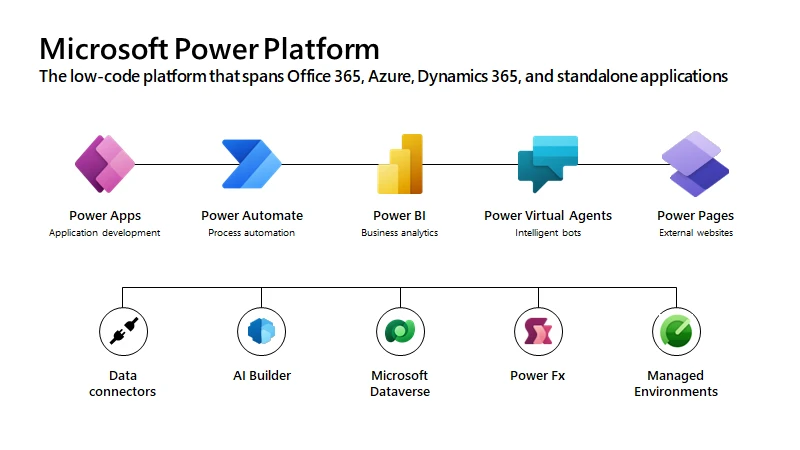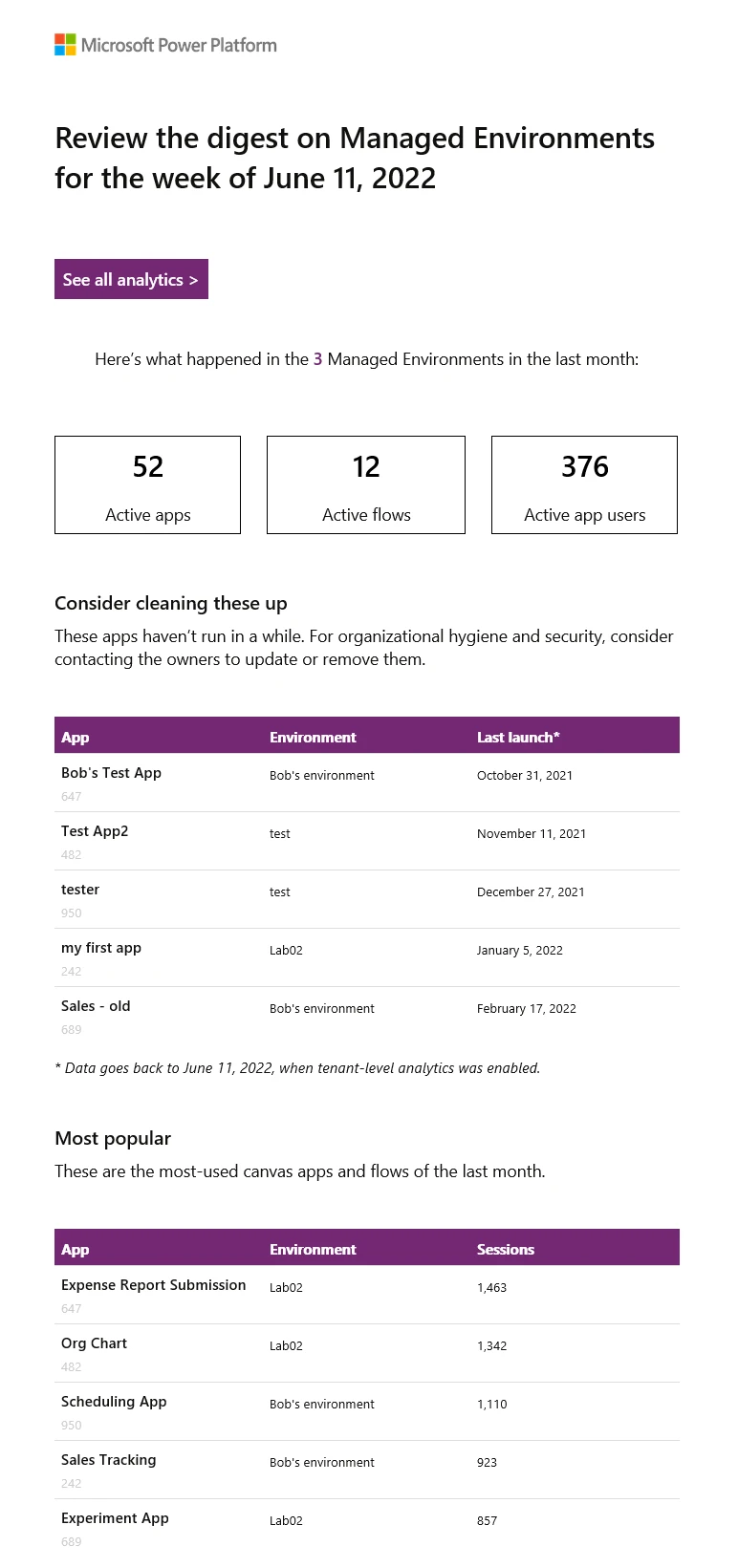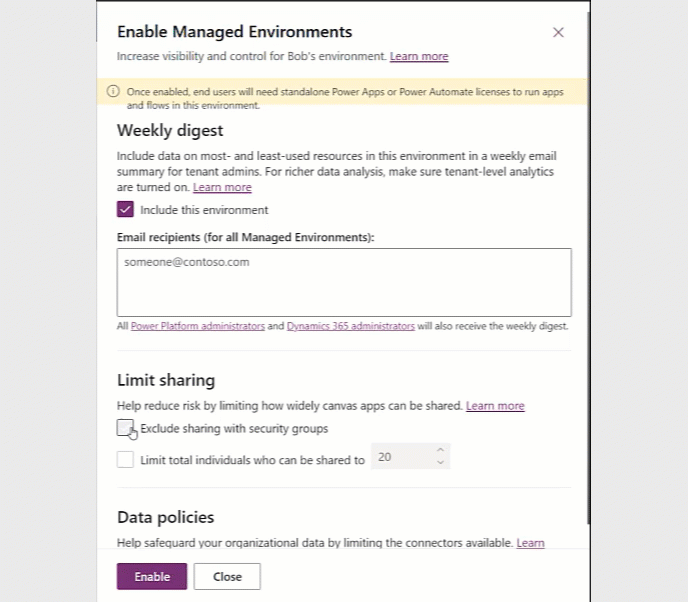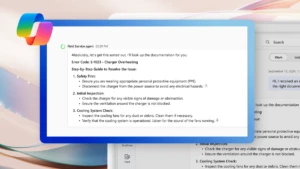
Govern low-code assets with Managed Environments for Microsoft Power Platform
Today, we are thrilled to announce a major new pillar investment area of Microsoft Power Platform: a capability called Managed Environments. Managed Environments offer a set of enhanced out-of-the-box governance capabilities that will simplify, automate, and streamline IT administration of Microsoft Power Platform at scale. The first wave of Managed Environment capabilities is now available in preview. Admins can select environments in the Microsoft Power Platform admin center and enable them as Managed Environments with a single click. What we are announcing today is just the beginning; Managed Environments will be enriched with more and more governance capabilities over the next few release waves.

Tens of thousands of organizations around the world are using the latest industry-leading security, compliance, and governance capabilities that are available today to manage the adoption of Microsoft Power Platform low-code assets across the company. Data policies help keep data safe, tenant-level analytics provide critical visibility, and the Center of Excellence starter kit offers best-practice templates.
However, customers are telling us that implementing these best practices requires a lot of manual work and expertise. Amongst configuring governance policies, user permissions, and capturing and sharing analytics, IT admins are often constrained with resources and time. This complexity increases exponentially as organizations look to scale their governance strategy to meet the growth of their implementation.
To address these challenges, we are igniting a new effort to offer out-of-the-box simplicity with premium administration capabilities for low-code asset management at scale. Managed Environments for Microsoft Power Platform is designed to streamline and automate governance at scale, increase IT trust, and significantly reduce the burden on IT. Admins can activate Managed Environments in any environment with just a few clicks and immediately get more visibility, more control, with less effort to manage all their low-code assets with greater peace of mind.
More visibility with admin digest
Getting a birds-eye view of the organization’s low-code adoption is critical to administering the platform. With the Managed Environments preview, admins will receive a weekly admin digest that provides proactive adoption insights, such as apps and flows that have not been active for a while and may need to be cleaned up. Rather than having to set up a Data Lake and build your own detection algorithms, these proactive notifications and recommendations are delivered directly to your inbox so that stale apps can be quarantined or cleaned up.

More control with sharing limits
Admins need the right knobs, dials, and controls to keep data and systems safe while at the same time allowing makers to take part in the company’s digital transformation. Managed Environments offers admins a simple way to block makers from sharing with security groups or specify how many people a canvas app can be shared with. These sharing controls help admins feel confident that apps can be reviewed before they are broadly distributed across the company.

Less effort with easy activation
Thousands of customers to date have adopted the Center of Excellence (COE) toolkit, and many have developed their homegrown custom solutions for analytics and advanced governance workflows. For example, to govern sharing, some customers have set up workflows to identify and block apps that were shared with too many people. With Managed Environments, all of this can be done proactively with just a few clicks. Over time, Managed Environments will be enhanced with more and more unique governance capabilities that will save admins time and effort, and allow IT to manage their low-code assets at scale with a lot more efficiency.
Included with standalone licenses
Managed Environments is a great option for customers that are all-in on Microsoft Power Platform. It is included with existing standalone Power Apps and Power Automate licenses—no additional license is required. When you enable Managed Environment on a selected environment, any user who runs apps or flows in that environment will need a Power Apps or Power Automate standalone license, respectively (such as per app, per user, or pay-as-you-go).
Managed Environments adds new benefits to the standalone license and an increasing value over time to these existing premium licenses. On top of access to 700 plus premium connectors and the rich capabilities of Dataverse, customers now get built-in governance best practices to manage low-code at scale with the click of a button.
Managed Environments preview
The preview for Managed Environments is rolling out this week. From the Microsoft Power Platform admin center, simply select an environment and click “Enable Managed Environments” to activate.
This is just the beginning of our journey to give IT admins more visibility, more control, with less effort. Over the coming release waves, Managed Environments will continue to increase the visibility, and the control they offer to low-code administrators, and in turn, allow admins to manage their Microsoft Power Platform adoption with a lot less effort. We would love to hear your feedback on Managed Environments preview by submitting it through this Microsoft Form to help inform our roadmap as we plan the next wave of capabilities.



